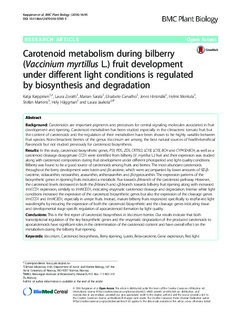| dc.description.abstract | Background: Carotenoids are important pigments and precursors for central signaling molecules associated in fruit development and ripening. Carotenoid metabolism has been studied especially in the climacteric tomato fruit but the content of carotenoids and the regulation of their metabolism have been shown to be highly variable between fruit species. Non-climacteric berries of the genus Vaccinium are among the best natural sources of health-beneficial flavonoids but not studied previously for carotenoid biosynthesis. Results: In this study, carotenoid biosynthetic genes, PSY, PDS, ZDS, CRTISO, LCYB, LCYE, BCH and CYP450-BCH, as well as a carotenoid cleavage dioxygenase CCD1 were identified from bilberry (V. myrtillus L.) fruit and their expression was studied along with carotenoid composition during fruit development under different photoperiod and light quality conditions. Bilberry was found to be a good source of carotenoids among fruits and berries. The most abundant carotenoids throughout the berry development were lutein and β-carotene, which were accompanied by lower amounts of 9Z-β-carotene, violaxanthin, neoxanthin, zeaxanthin, antheraxanthin and β-cryptoxanthin. The expression patterns of the biosynthetic genes in ripening fruits indicated a metabolic flux towards β-branch of the carotenoid pathway. However, the carotenoid levels decreased in both the β-branch and ε,β-branch towards bilberry fruit ripening along with increased VmCCD1 expression, similarly to VmNCED1, indicating enzymatic carotenoid cleavage and degradation. Intense white light conditions increased the expression of the carotenoid biosynthetic genes but also the expression of the cleavage genes VmCCD1 and VmNCED1, especially in unripe fruits. Instead, mature bilberry fruits responded specifically to red/far-red light wavelengths by inducing the expression of both the carotenoid biosynthetic and the cleavage genes indicating tissue and developmental stage specific regulation of apocarotenoid formation by light quality. Conclusions: This is the first report of carotenoid biosynthesis in Vaccinium berries. Our results indicate that both transcriptional regulation of the key biosynthetic genes and the enzymatic degradation of the produced carotenoids to apocarotenoids have significant roles in the determination of the carotenoid content and have overall effect on the metabolism during the bilberry fruit ripening. | nb_NO |
